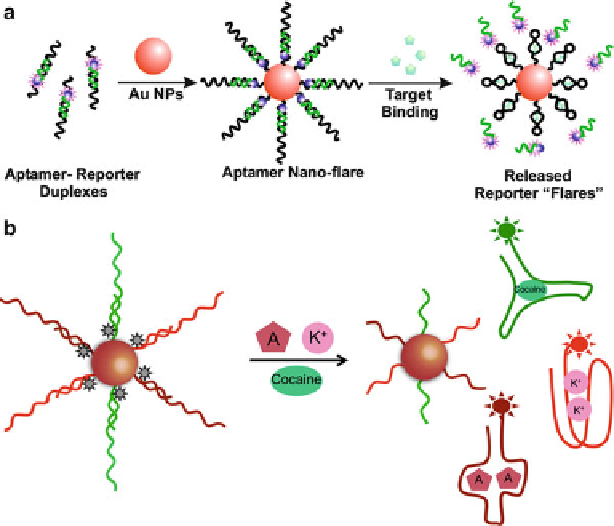Biomedical Engineering Reference
In-Depth Information
Fig. 13.5
(
a
) Schematic illustration of target molecule responsive aptamer nano-flare, which
can be used for quantitatively fluorescent detection of ATP in living cells (Reprinted with
the permission from Ref. [
72
]. Copyright 2009 American Chemical Society). (
b
) Multiplex
fluorescent detection of adenosine, potassium, and cocaine based on a multicolor aptamer-based
gold nanoprobe
Recently, Mirkin and coworkers developed an aptamer-AuNP composite nano-
material, termed aptamer nano-flare, for quantitatively detecting ATP in living cells
(Fig.
13.5
a) [
72
]. These hybrids consist of a gold nanoparticle that is functionalized
with ATP aptamers hybridized to fluorophore-labeled flares. The aptamer nano-flare
binds to target molecules selectively and releases fluorescent reporters, which can
detect intracellular ATP concentrations at 1-2 mM.
Since AuNPs can efficiently quench almost all fluorophores, it is possible to
develop sensors for multi-analysts detection with one particle [
73
-
75
]. Fan and
coworkers reported a multicolor gold nanoprobe for the simultaneous detection of
three analytes: adenosine, potassium ion, and cocaine (Fig.
13.5
b) [
73
]. In their
design, different dyes are brought close to the AuNP surface through hybridization
of three types of attached ssDNA and dye-labeled aptamer, which results in efficient
AuNP-quenched fluorescence. In the presence of the targets, the specific target-
bound aptamer releases the corresponding dye-labeled aptamer into solution and
recovers the specific fluorescence.

Search WWH ::

Custom Search